Cargo
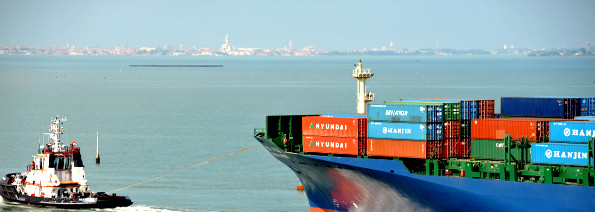
Venice boasts one of Europe's top ports for break bulk and project cargo traffic. [1] Venice is considered one of the major ports in Europe for general cargo traffic. Import primarily consists of iron, steel, and marble, while exports are especially represented by project cargo. Venice serves as one of the important points of cargo transfer on the Adriatic Sea.
The base of Venice's economy always has been maritime trade and the Port of Venice has become a center for trade between Europe, Asia, and the Middle East. [2] As a result, shipbuilding has become an important economic sector for the Port of Venice. Additionally, many small and family-owned businesses produce high-quality products to be shipped around the world.
Venice, with its strategic geographical position and plentiful space, will serve as a major port in Europe for years to come.
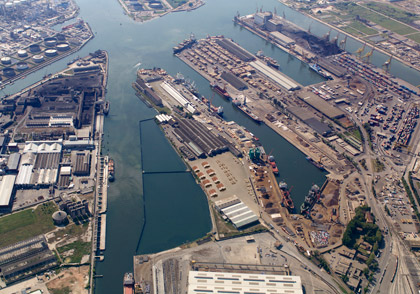
Identification of Cargo
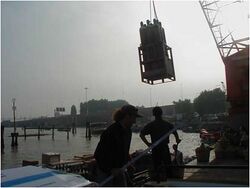
Cargo is defined as goods or merchandise that is conveyed in ship, airplane, or vehicle; cargo in Venice is primarily conveyed by ship. There are three main types of cargo to be examined in Venice: non-refrigerated, refrigerated, and unit loads. [3] Each type of cargo has special needs to ensure its successful delivery.
Perishable Cargo
Perishable cargo refers to goods that are subject to spoiling and decay over time without special care taken. Most perishable items being shipped in and out of Venice are food items such as fruit, vegetables, butter, milk, meat, and eggs. These items require refrigeration to avoid the dangers of enzymes and microorganisms.
Unit Load
A unit load consists of one large package or numerous smaller packages that are bundled together to form a larger shipping unit. The unit load is often heavy and large, but is far more economical to ship when compared to smaller-scale shipping.
Cargo Boat Characteristics
There are many different kinds of cargo boats in Venice. The cargo boats vary in their dimensions, cargo capacity, engine size, and deck space. The cargo portion of the vessel only takes a portion of the entire volume of the boat. After considering space for the engine and helm, only about 70 percent of the total vessel volume is reserved for cargo.
General Cargo Boats
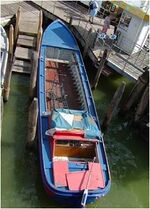
Despite some variations in the makes and models of cargo boats, most have similar dimensions and key characteristics. Most cargo boats are considered to exhibit two levels for cargo storage. Cargo boats have a hollow hull for the storage of cargo which is then covered by boards to create a second level for cargo storage. The lower cargo hold can be utilized as a means to keep cargo away from elements such as rainy weather or choppy seas.
On any given day, a general cargo boat will ordinarily be found carrying food, beverage, and household goods. In some instances, the general cargo boats will have a specialized role in delivery, such as carrying Murano glass products throughout the city.
Refrigerated Cargo Boats
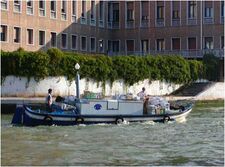
Approximately 28 percent of cargo boats used in Venice are refrigerated. The majority of the cargo boat is consumed by the refrigeration unit. The general structure of the refrigerated cargo boat can be found in the image to the right. The cargo boat containing a refrigerated unit is utilized for those goods that may spoil or decay if not kept under certain prescribed temperature conditions.
Construction Boats
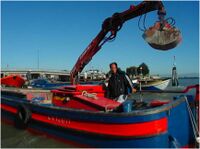
There are approximately 100 construction boats in Venice. The construction boats in Venice tend to be larger dimensionally than the many other cargo boats that exist in Venice.
Though metal boats have been banned in Venice, many exceptions have been made for construction boats. It has been found that metal boats tend to sit deeper in the water and create greater wake damage throughout the city of Venice.
Construction boats are responsible for the transport of building materials and demolition debris. A crane is often utilized in construction boats, as demonstrated in the image to the left, as a means to aid in transportation of bulkier materials.
Docking Locations
Riva
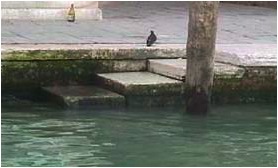
Fondamenta
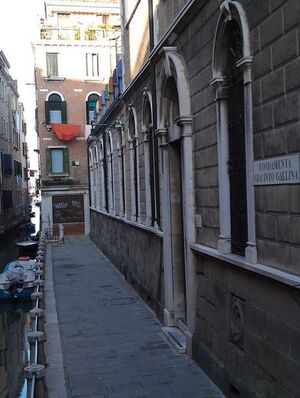
Pontile

Cargo Transportation System in Venice
Conto Proprio
The more common type of transport in Venice is conto proprio. With conto proprio, boats are owned by the companies to which they deliver their goods. For example, the four McDonald's located in Venice have boats which are solely dedicated to the delivery of their company's goods.It is actually considered illegal if these boats were to deliver goods to a company other than that which they are devoted to.
Conto Terzi
Conto terzi involves those boats that deliver cargo for third parties. These boats have additional licenses that allows them to legally transport goods for third parties. Boats under conto terzi can also benefit private citizens in the city of Venice if they have a large shipment that may not fit on a private boat.
Required Licenses
There are many different licenses that must be obtained to own, drive, and park a cargo boat in Venice. There are six in particular, and they serve the following functions:
1. Register your company with the Chamber of Commerce
2. Driver's certification showing that the boat operator is qualified to drive cargo boat
3. Shipping license specific to boat drivers who travel in internal waters
4. Plates and registration of boat
5. Permit to park the boat within the city overnight and designates a parking space
6. Separate license plate for third party transporters
The Port of Venice
The Port of Venice is located at the top end of the Adriatic Sea, at the intersection of the main European transport corridors and the Motorways of the Sea. It is in a position to act as the European gateway for trade flows to and from Asia.
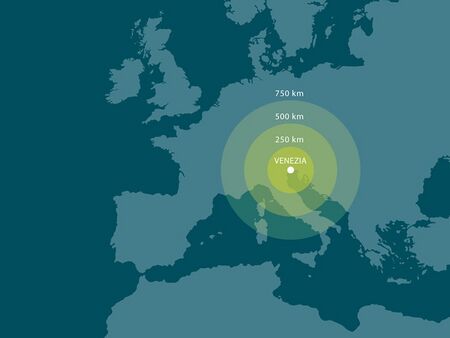
Goods
Venice is one of the leading ports in the Adriatic for containers handled. [4] New lines connecting Venice with the far East, the new terminal and off shore platform will continue to consolidate its leadership. The port is also one of the leading European ports for project cargo, with a scope that includes all of Central Europe. Furthermore, the port is specialized in general cargo and ranks as the third European port for this type of transport.
Passengers
The Port of Venice acts as the leading Mediterranean homeport for cruise ships. [5] Since it exhibits several passenger terminals, it can cater to cruise ships, ferries, yachts, and mega yachts. The passenger port has become committed to protecting the environment and and is especially attentive towards sustainability issues.
Institutions
The Venice Port Authority is a public body meant to guide, plan, coordinate, promote, and monitor port operations. [6] It is in charge of maintaining common areas and the seabed, overseeing supply of services of general interest, managing state maritime property, and planning development of the port. Ultimately, the Venice Port Authority aims to respect the environment and be safe, open, and ethical.
See Also
References
- ↑ "Port of Venice- Where the Earth revolves around the Sea" North Adriatic Ports Association. Retrieved 15 October 2011
- ↑ "Port of Venice- Port Detail" World Port Source. Retrieved 15 October 2011
- ↑ "Re-Engineering the City of Venice's Cargo System" . WPI Interactive Qualifying Project. Retrieved 15 October 2011
- ↑ "Port of Venice Goods" Authorita Portuale di Venezia. Retrieved 15 October 2011
- ↑ "Port of Venice Passengers" Authorita Portuale di Venezia. Retrieved 15 October 2011
- ↑ "Port of Venice Institutions" Authorita Portuale di Venezia. Retrieved 15 October 2011
Bibliography
NULL